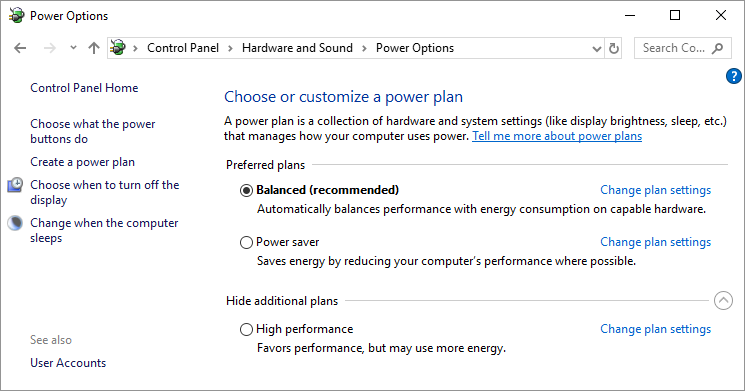Choosing a Power Management Plan
It's obvious that your computer uses power; it has to in order to operate properly. You can, however, minimize the amount of power your computer uses by changing Windows' power settings. You can access those settings in this manner:
- Display the Control Panel.
- At the left side of the screen click the Hardware and Sound heading. Windows displays the Hardware and Sound screen.
- Under the category of Power Options, click the Change Power-Saving Settings option. Windows displays the Power Options screen. (See Figure 1.)

Figure 1. The Power Options screen.
- Pick one of the power management plans available on the screen.
Most modern computers allow Windows to control both the computer itself (including the hard drive) and the display monitor. These components can be set to automatically "turn off" after varying amounts of inactivity. Windows offers three power management plans that you can select in step 4:
- Balanced. This is typically the plan recommended for desktop systems. It turns off the display monitor after 10 minutes and puts the computer to sleep after 30.
- Power Saver. This plan works great for laptop and mobile systems. It turns the display off after 5 minutes and puts the computer to sleep after 15.
- High Performance. This plan is designed for systems that may require a lot of unattended computational time, where you don't really want the computer to pause what it is working on. It turns off the display monitor after 20 minutes and never puts the computer to sleep.

 This tip (10716) applies to Windows 7 and 10.
This tip (10716) applies to Windows 7 and 10.
Author Bio
Allen Wyatt
With more than 50 non-fiction books and numerous magazine articles to his credit, Allen Wyatt is an internationally recognized author. He is president of Sharon Parq Associates, a computer and publishing services company. Learn more about Allen...
Changing the Height of a Font
Scaling the width of a font is easy to do with Word's formatting capabilities. Scaling the height of the fonts is not so ...
Discover More
Changing Page Margins
If your worksheet is destined to be printed, you'll need to be concerned with how it appears on the page. One layout ...
Discover More
Only Showing the Maximum of Multiple Iterations
When you recalculate a worksheet, you can determine the maximum of a range of values. Over time, as those values change, ...
Discover More
Wiping a Drive
Want to easily improve the security of your old data? Here's an addition to the venerable format command that can help.
Discover More
Quickly Reset Your Graphics Driver
Resetting your graphics driver can help when your computer is facing issues. Execute a quick rest of your computer's ...
Discover More
Estimating Battery Life
The battery in your laptop provides the power you need to even use the system. As you use your laptop, you may notice ...
Discover More

![]()
![]() This tip (10716) applies to Windows 7 and 10.
This tip (10716) applies to Windows 7 and 10.
Comments